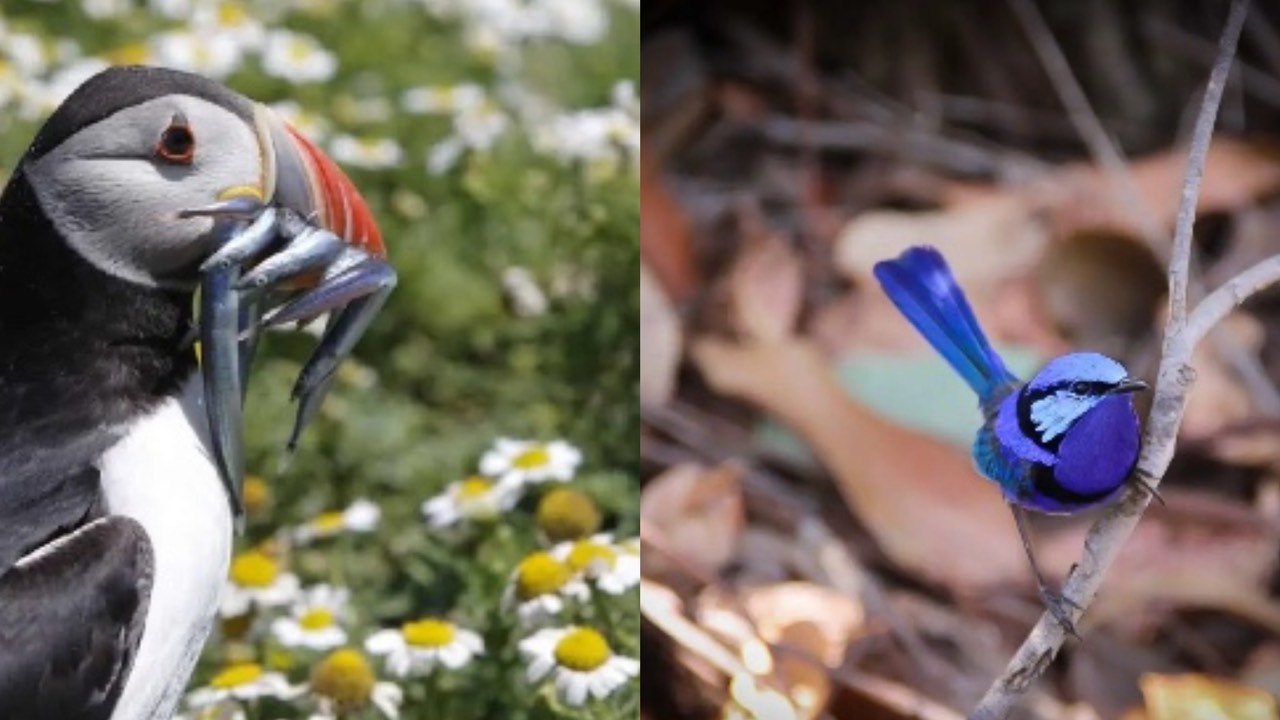
With so many different types of birds, it has been challenging to choose the 20 most beautiful birds in the world. So I’ve reached out to other bloggers around the globe to put together this post which includes our top pick of the most beautiful birds of the world.
Wherever you go in the world you’re likely to see a bird or hear them sing. Whether you’re in a city, up a mountain, in the rainforest, or even the desert, they’ll be at least one of 10,000 species of birds in the world living there.
I’ve been fortunate enough to see some amazing birds on my travels, particularly in South America, Australia and Thailand.
If you’re travelling to these countries it’s worth going on a bird watching tour as you learn much more about the types of native birds by having a guide.
Carrying a pair of birding binoculars is recommended, particularly if you want to catch small birds or those in the distance. For more information on the best binoculars for birding click here.
This article may contain compensated links. Please read my disclaimer policy for more information.
Sit back, grab a brew and enjoy reading about these beautiful birds.
Pictures are included and the location of where you can go to enjoy views of these beautiful bird species.
There are also some facts about birds to enjoy along the way and information on the best bird books to buy.

I’ve travelled in Africa a fair bit, including going on safari in Tanzania, and one of the most beautiful birds I’ve seen there is the lilac-breasted roller.
Lilac-Breasted Rollers can be found widely throughout sub-Saharan African and the southern Arabian Peninsula.
With their vibrant colours – blue or green head, turquoise belly, brown back, and of course that beautiful lilac breast, they make an eye-catching sight against the dusty yellows of the African savannah plains where they live.
Learn more about a self drive safari in Botswana or Pilanesberg in South Africa. You can spot Lilac-Breasted Rollers in both these destinations.
The Lilac-Breasted Roller gets its name not only from its plumage but also from its courtship ritual.
During mating season, the male performs an aerial ballet, flying high and then swooping down low, diving, rolling, and calling out to attract a mate.
Rollers are easy to spot because as well as being brightly coloured, they tend to live in open savannah areas and are unafraid of humans.
They’ll happily perch on a branch or vantage point by the roadside looking out for prey such as small insects and snails, and if you pass one in your car, there’s a good chance you’ll be able to get a photo before he flies away.
When the roller spots a tasty morsel, he’ll swoop down and grab it, then violently bash it to death against the ground before swallowing it. So while they’re one of the prettiest birds in the world to look at, it seems they have a nasty streak!
Chosen by Bella of Passport and Pixels
Are you heading to Africa? This book on the Birds of East Africa is a best seller on Amazon and an excellent accompaniment if your heading to this part of the world bird watching.
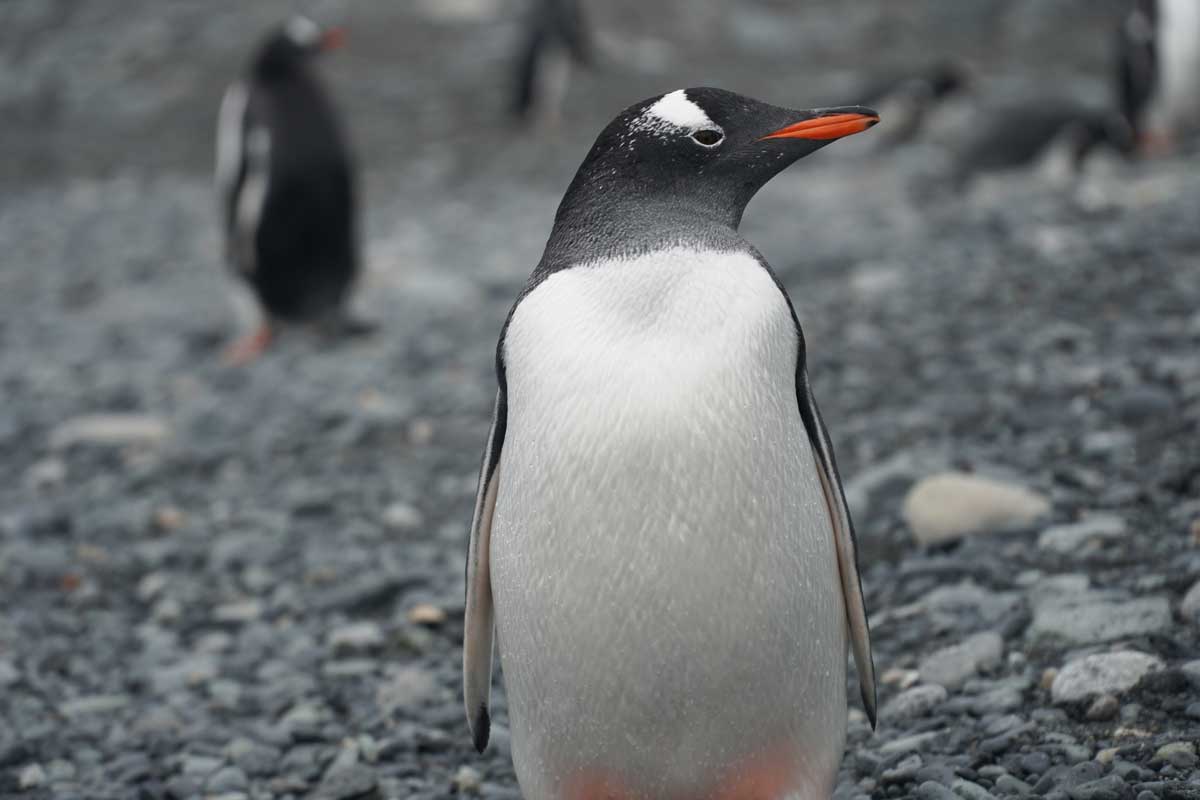
Gentoo Penguins (Pygoscelis Papua) are one of the least common penguins you’ll find in Antarctica. However, when we were there in late summer, it was nesting time, and there were lots of them.
We found colonies of these flightless birds and their babies throughout the region, including on high hills where snow does not accumulate during the late spring or summer – the perfect rocky nests for Gentoos.
Fact – Penguins are the only birds that can swim but not fly. Gentoo Penguins are the fastest swimmers of all.
To increase your chances of getting as close as possible to these gorgeous birds, find a place to sit nearby and don’t move.
While it is prohibited for humans to initiate contact with Antarctica’s wildlife, that doesn’t mean it applies the other way around.
It’s possible, even likely that one or two penguins may be curious enough about you to come by and check you out.
To get the birds photos you have to be patient. So, dress warmly for Antarctica, sit on a rocky beach near the colony, and wait for a Gentoo. It’ll be the highlight of your trip to the continent!
Looking at taking a trip to Antarctica? Cruises often depart from Ushuaia in Patagonia. Click here to learn more about El Fin del Mundo (the end of the world).
Halef and Michael of The Round The World Guys
Heading to the Antartica? This book will ensure that you can identify your penguins, sea birds and marine life with confidence. The vibrant images are beautiful, and the text gives lots of information about the challenges encountered by wildlife in this remote area.
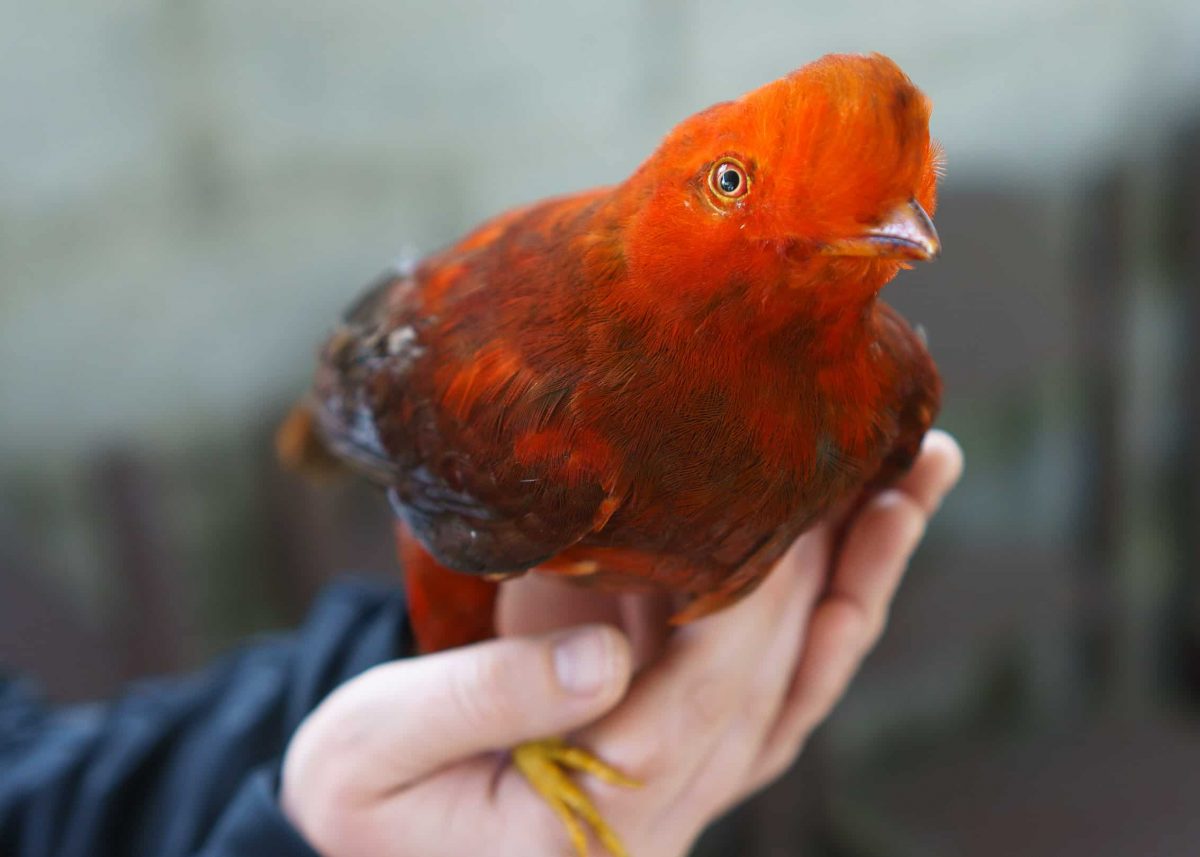
I’m a self-proclaimed bird nerd and find it very hard to pick a favourite bird; they’re all so magnificent in their own way. That said, one incredibly beautiful bird that I had the pleasure of seeing is an Andean Cock of the Rock in the birdwatcher’s paradise of Mindo, Ecuador.
The males of the species are known to practice their courtship moves together in noisy groups called “leks” that form at the crack of dawn.
They are famous for their brilliant ruby-red plumage and voluminous crests. The females are more subdued, but beautiful nonetheless and tough as nails as I learned in Mindo.
I was watching a diverse group of tanagers, toucanets, and hummingbirds at the San Tadeo bird blinds when the owners came by with an injured female Andean Cock of the Rock. She had been hit by a car, and they found her by the road. They placed her in my hands and said to look after her while they went to work. I held her for a bit before finding a quiet spot for her to recover.
She sat quietly for about an hour before flying to the top of a nearby tree. There she remained for another 30 minutes before taking off and disappearing into the thick tree canopy. I’ll never forget my close up encounter with such a beautiful and tough bird!
Thea of Zentravellers
Mindo is a fabulous place to visit, and there is lots for all the family to do as you can discover by clicking here.
There are so many birds in Ecuador that most guides are too hefty to carry with you when you travel. This book is considerably more compact, but it features 946 species and includes detailed field maps and the bird’s name- with picture.
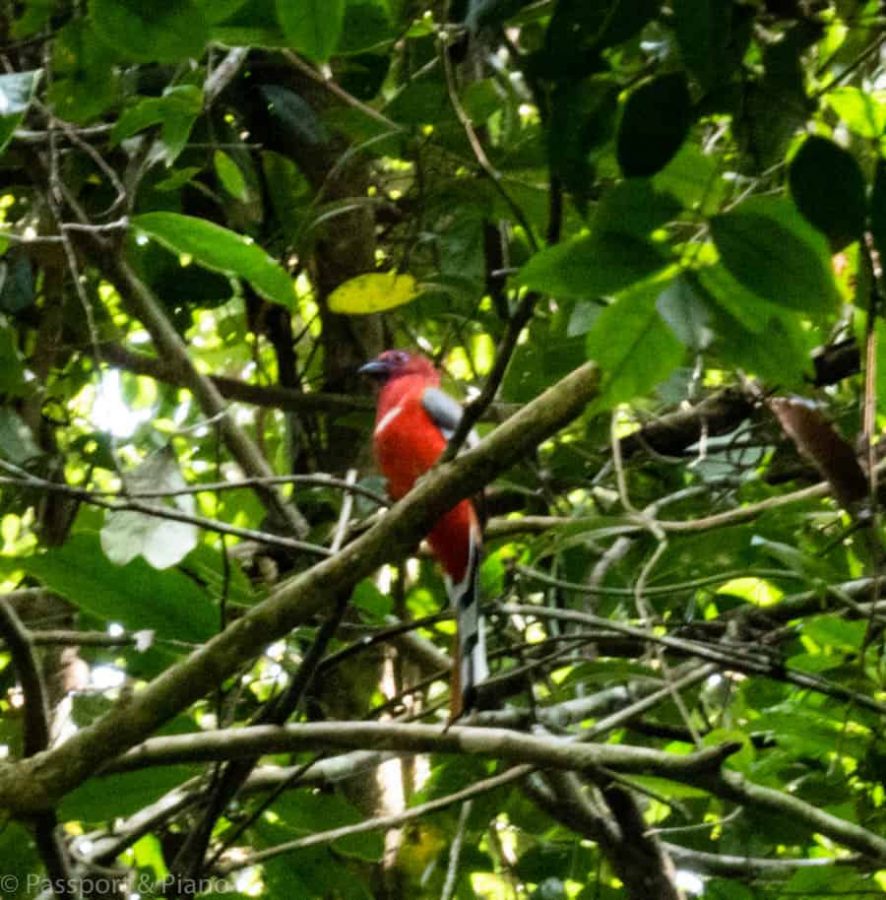
There are so many types of beautiful tropical birds, and the male Red-headed Trogon is one. I think red coloured birds are always striking, but the tail feathers are particularly so on this tropical bird.
The feathers form a black and white striped pattern which is stunning next to the red plumage of the upper body. The purple circle around the large eye is also attractive.
You can spot the Red-Headed Trogan in northeastern India, Bangladesh and Southeast Asia. I took the photograph above on my recent visit to Khao Yai National Park in Thailand.
The park has around 300 species of birds, and I enjoyed several days bird watching which resulted in some fantastic colourful birds pictures.
You’d think being red they’d be easy to spot, but that is not the case. They often perch in the trees of tropical and subtropical forests, and the dense foliage hides them well.
They feed mainly off insects, but they also enjoy bamboo leaves and berries.
Compared to other birds little is known about their breeding habits and numbers but they are not on the IUCN list as a cause for concern.
There are good numbers reported in Northeast India and Vietnam, but it appears that they are declining in Thailand and Nepal.
Fiona from Passport and Piano

Standing in the forest, the sound gets louder and louder; it resembles the sound of helicopter blades getting closer. It seems a strange place for a helicopter to land, then you realise that it isn’t any man-made machine making that noise, its a bird.
This huge bird is the Great Hornbill – 2-4 kgs with a 1 ½ meter wingspan. It’s massive beak, and distinctive ‘horn’ is bright yellow in colour, contrasting with its black and white feathers. The Great Hornbill is a stunning bird.
We last saw Great Hornbills in Kaeng Krachan National Park in Thailand, a park justifiably popular with bird watchers, not only for the hornbills but also the range of other bird species.
A guide will show you where the Great Hornbills often hang out, and then you wait for the tell-tale sound of their approach.
The birds then hop from tree to tree, picking berries with their enormous beaks, the branches bowing with their great weight and looking like they might fall. Then, the noise starts up again and off they go.
Kate and Kris of What Kate and Kriss Did
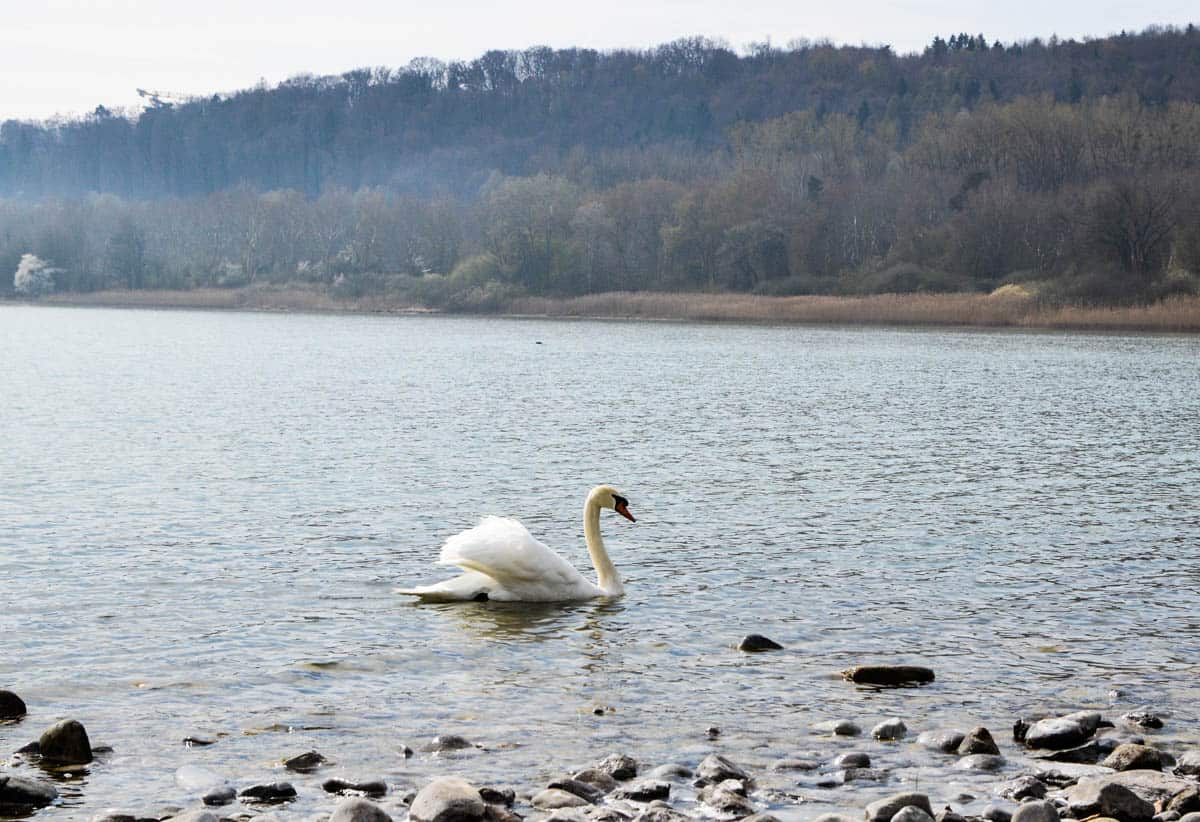
Swans are unique water birds, known for their elongated S necks and beautiful white plumage. While swimming, the birds seem to float effortlessly along the water.
Mute Swans(Cygnus olor,) are in abundance along riverwalks and lakes in Germany. The swans seen above were swimming next to the beautiful flower island of Mainau.
Swans are beautiful white birds. They are considered the most elegant and graceful of birds and their symbolism is rooted deep in history.
They are among the largest and most beautiful flying birds needing a long area of land or water to take flight. Swans can fly up to 60 mph and weigh up to 30 pounds. They are also monogamous birds, known for mating for life.
There are at least seven known types of Swans, with the Mute and Trumpeter Swans being the most common.
Swans typically live in the wild and can be found in marshes, ponds, lakes, rivers and other areas with open water.
Fiercely protective of their young, swans will attack animals and people if anything or anyone threatens their young.
Known mainly as a white-feathered bird, swans can also be black and or a mix of black and white in the southern parts of the world.
Diana of The Elusive Family
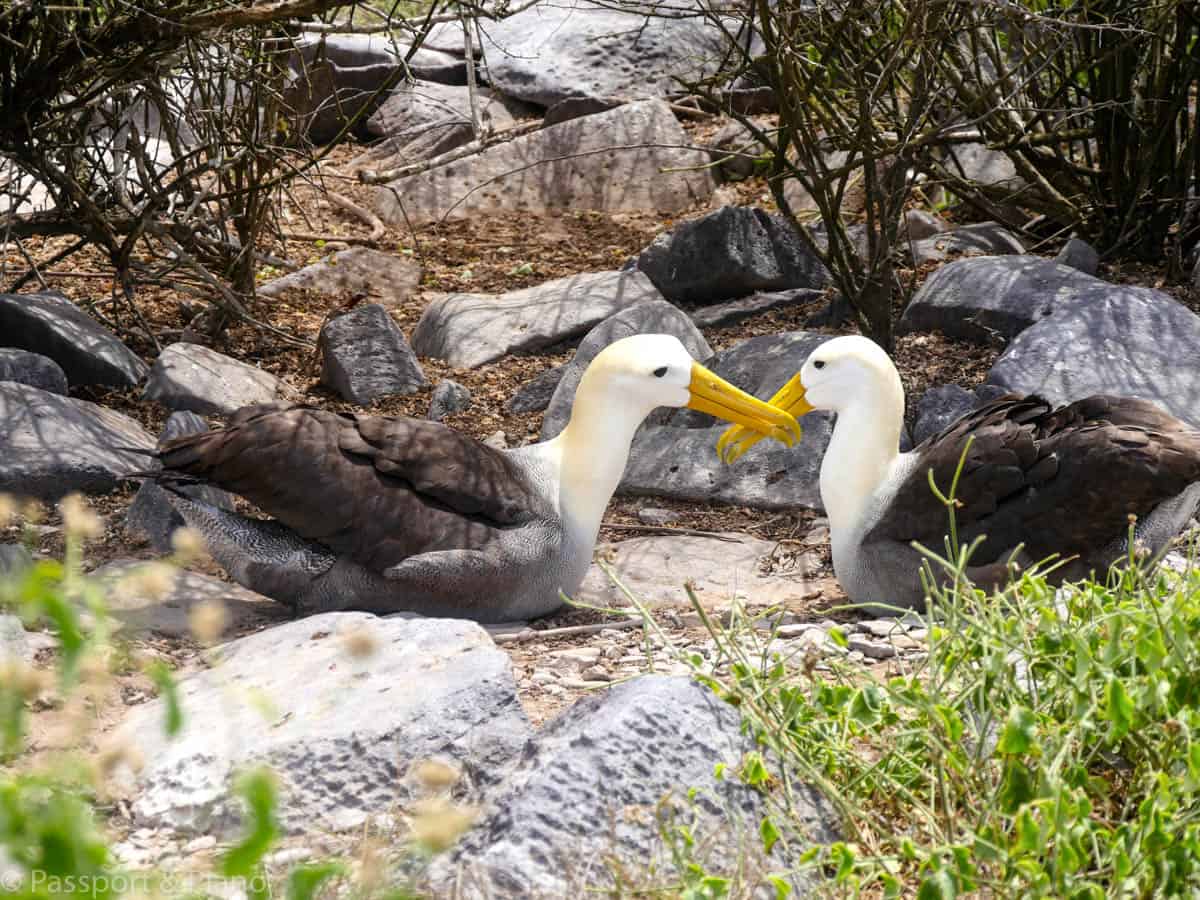
The Waved Albatros (Phoebastria irrorata) is another beautiful white bird, and like the swan, they are amongst the largest birds that can fly. They also mate for life, and both parents take it in turns to sit on the nest and care for their young.
Sadly all 22 species of Albatross, are registered as a concern, and three even make it onto the critically endangered bird’s list. The Waved Albatross is one, which is so sad given it’s such a big beautiful bird.
We visited Espanola Island especially to see these beautiful big birds of the world. The island is a protected breeding site in the Galapagos, and we were lucky enough to visit during the breeding season.
If you’re thinking of going to the Galapagos Islands you can read all about planning a land-based itinerary here.
I was fascinated by there mating behaviour, in particular, the way they circle their beaks and tap them together in a kind of courtship dance. When they walk or should I say waddle, they’re highly amusing. I spent several hours photographing them as you can see from the beautiful bird images above.
The wingspan of a waved albatross is approximately 2.2 metres, and they use a method called dynamic soaring to travel vast distances. Getting pictures of birds flying is never easy, but as the Albatross circled so gracefully around us in the Galapagos, it was made easier.
Fact – An Albatross can soar for up to six hours without moving its wings.
Their numbers are so vulnerable as they lay only one egg per couple. However, in recent years the most significant threat has come from longline fishing and plastic in the ocean.
Many of the worlds leading organisations are now involved in conservation efforts to protect these rare birds of the world.
You can read more about the efforts of the RSBP in the UK here, the Cornell Lab of Ornithology here or Birdlife International here.
Fiona from Passport and Piano
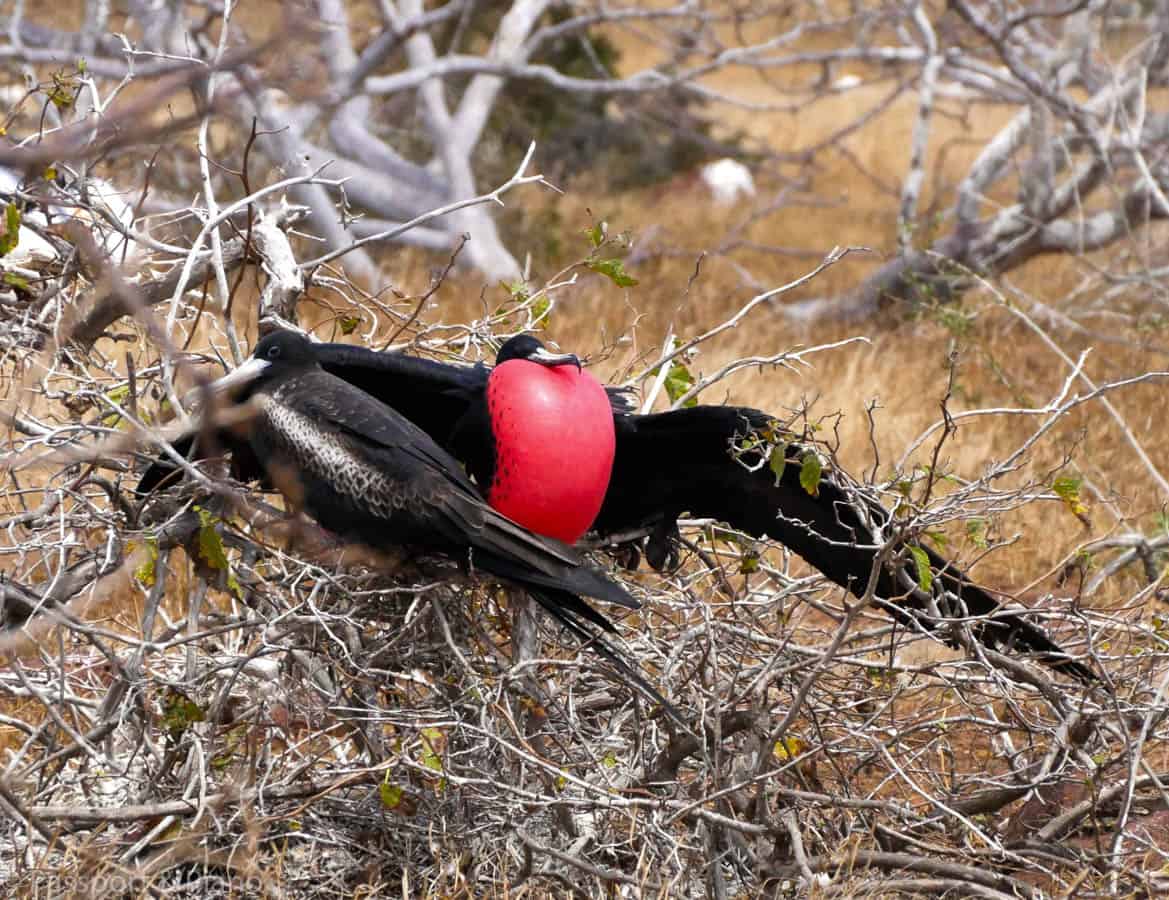
Another bird of the Galapagos Islands that I feel deserves a place on the list of 20 most beautiful birds in the world is the Magnificent frigate-bird.
You can read more about North Seymour Island where you’ll find these birds in this post on Santa Cruz.
The male of the species is perhaps one of the coolest birds in the world. During the mating season, you’ll see several males surround a female and inflate their red pouches.
The vibrant red pouch is stunning as you can see on the amazing bird’s photos that I took on North Seymour Island.
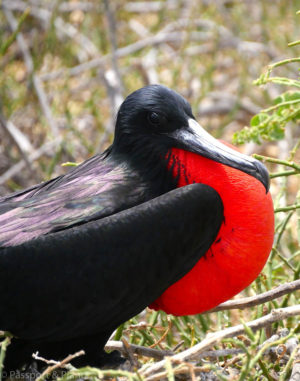
You’ll also notice in these beautiful birds images how long their wingspan is and how attractive their black feathers are with their purple sheen.
What also makes them amazing is that females care for the young for a further nine months after the male leaves which is the longest of any bird in the world.
Fact -The Magnificent Frigate bird cares for its young longer than any other bird.
Furthermore, the magnificent frigate bird has the largest wingspan to body ratio of any bird in the world. Weighing on average 1.1kg with a wingspan of 2.15m they are in my opinion one of the best birds in the world.
Fiona from Passport and Piano
This is a fabulous book, which was of great help both in planning my recent trip to the Galapagos and as a pocket field book when you get there. It tells you the best places to visit and what you can expect to see there with a good overview of the plants and animals.
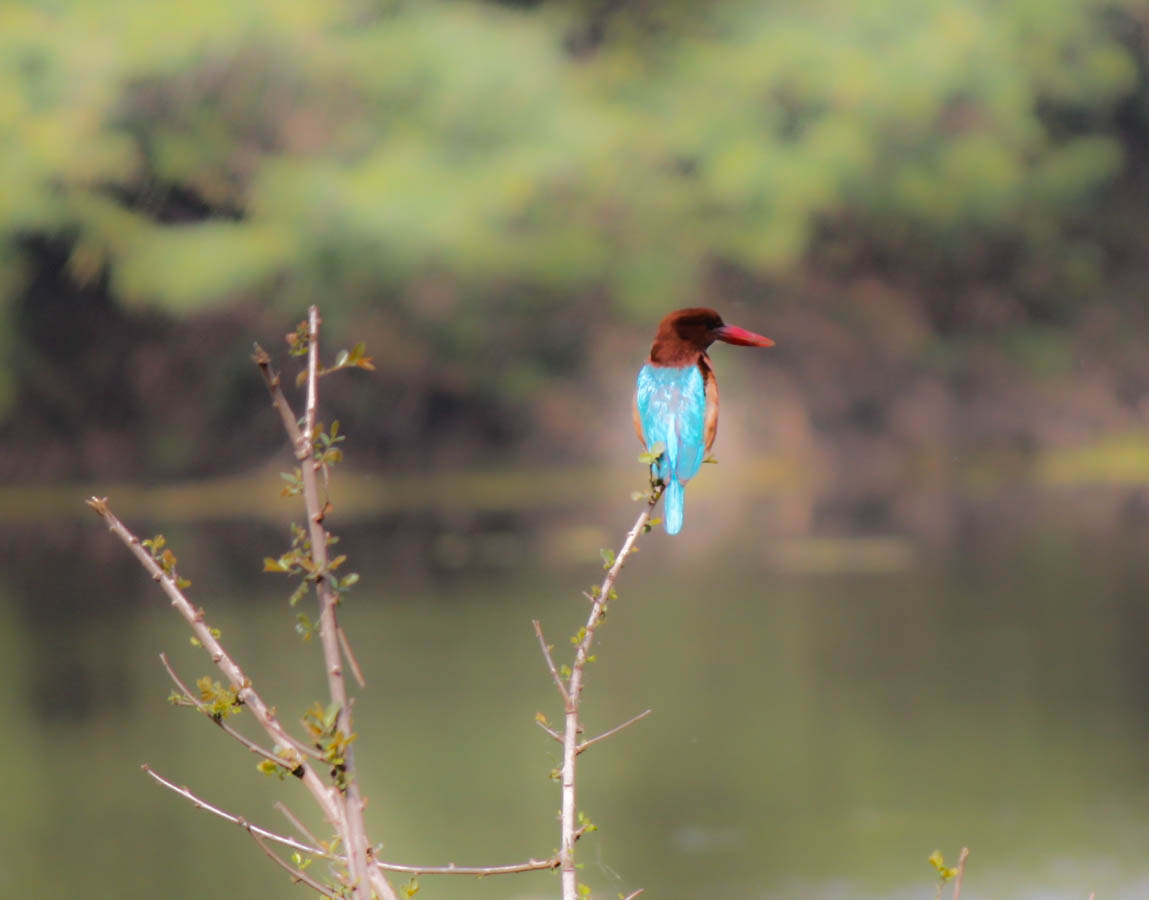
The Keoladeo Ghana National Park in Rajasthan in India is a boon for birding enthusiasts. With over 230 resident Indian birds and other migratory birds in the region your sure to capture some beautiful birds photos. The challenge, however, is having a sharp eye not to mention the ability to get up close.
Despite being near to the Golden Triangle, tourists do not often visit the National Park. This is probably a blessing in disguise as the sanctuary isn’t strewn with large camera-carrying groups.
When I visited in February, there were very few people around. I had been advised to visit the large pond where I was told many birds come to dip their toes and take a drink.
I got as close as possible and began looking around in the hope of capturing some birds pictures. Out of the corner of my eye, a small colourful bird caught my attention. As I looked closer, I saw a beautiful Kingfisher in flight that landed on a tree branch just a few metres from me.
I didn’t want to scare him, but I also wanted to get some beautiful birds pics before he disappeared. Thankfully, I managed to capture him just as he flew away into the trees.
In India, you often celebrate the coming of age with your peers and a drink. The country’s favourite beer is called Kingfisher, so it’s not only one of the most beautiful birds in India; it’s also a great beverage.
Priyanko Sarkar of Constant Traveller
This is a handy book to fit in your backpack, with useful maps, identification tables and helpful images with lots of pictures of different birds. I work in India frequently, and this book was recommended to me by local bird watchers.
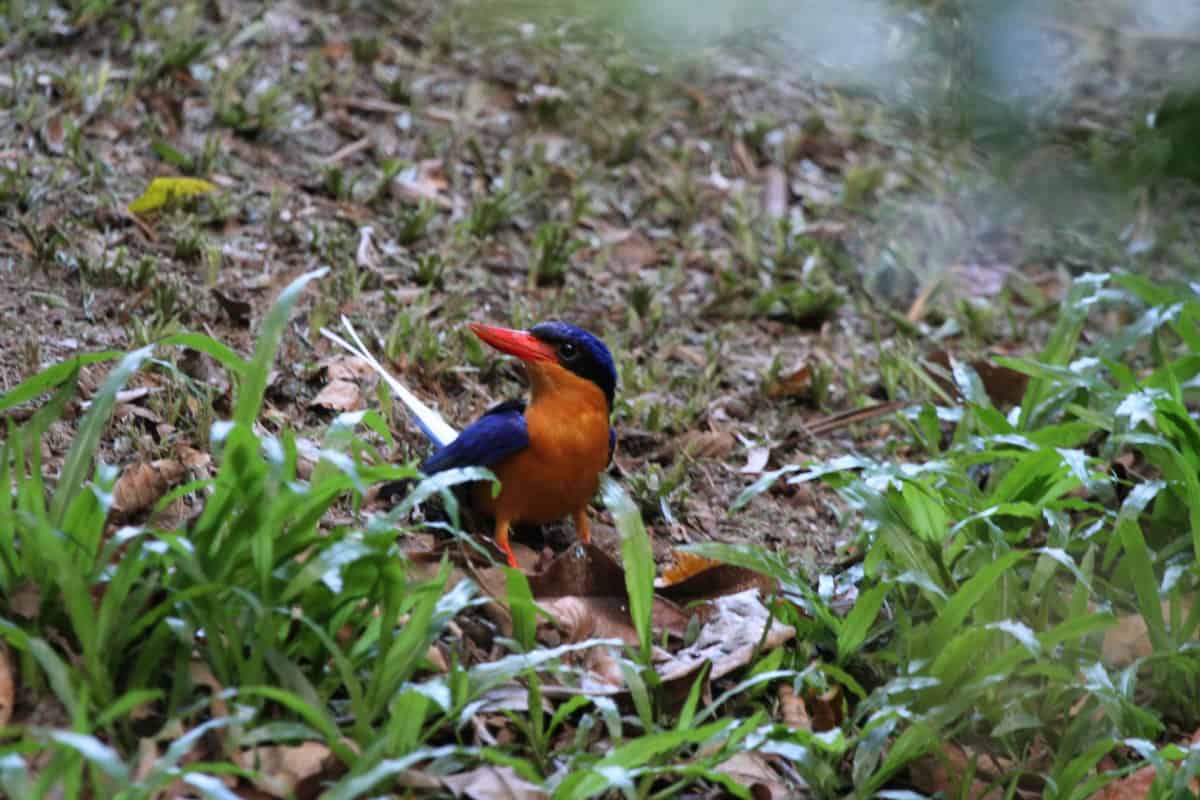
It seems that Priyanko of Constant Traveller is not the only one to consider the Kingfisher as the most beautiful bird species.
Sophie of Lifestyle Queensland has also chosen a member of the Kingfisher family as her favourite.
I am fortunate that the lush rainforest area I live in is teeming with rainforests birds. Just google “Lockhart River birdlife”, and you’ll understand! We’re most famous for our rare black palm cockatoo, but unfortunately, it probably wouldn’t win any beauty contests.
The Buff-Breasted Paradise Kingfisher, on the other hand, is the most beautiful bird in world I’ve ever seen!
A member of the kingfisher subspecies, the Paradise Kingfisher, spends most of the year in Papua New Guinea. During the breeding season, (November to April) they migrate over to the rainforests of coastal Far North Queensland.
This is an epic journey, for such a small bird, 80km across the ocean plus further to their breeding destination. I managed to see one up close and personal once when it flew into our window and I had to quickly grab him before the dogs saw.
I felt pretty lucky to get such a rare opportunity as, despite being one of the most colorful birds, they can be very elusive and hard to spot. After 10 minutes, sat on a high ledge, he was happy again and off he flew to find his mate. Like other kingfishers, they are very brightly multi-colored birds.
The back and wings are almost an electric blue colour, which is beautifully contrasted against the bright yellow of the fluffy breast feathers (hence the buff-breasted name). The main identifying features are a bright white spot on the back, a jet black stripe across the eyes, red beak and impressively long tail-feathers, usually coloured white.
Sophie of Lifestyle Queensland
Want to know the best places in Australia to spot birds? This book is excellent, with the best sites to view both common are rare species throughout the country. Detailed maps alongside stunning birds images make this a must buy for bird enthusiasts heading to Australia.
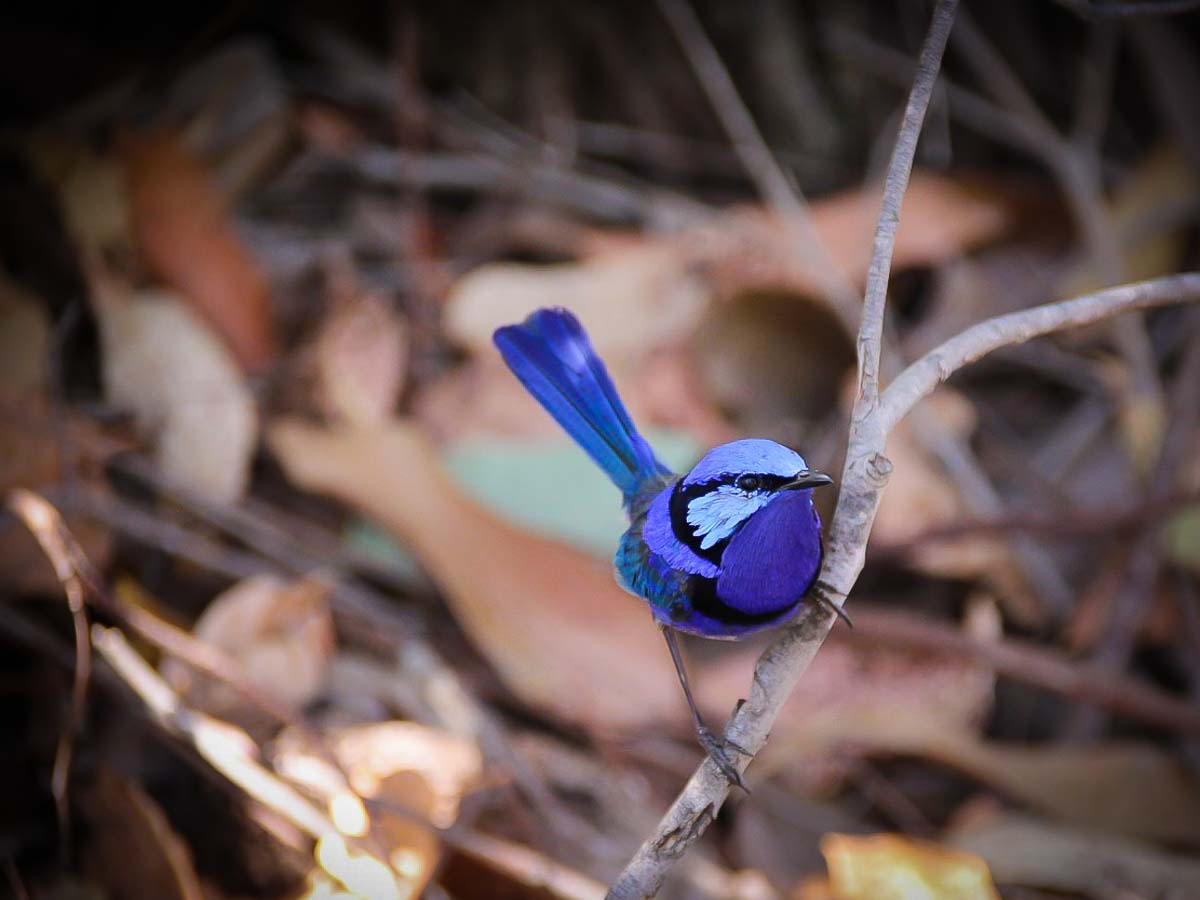
There are many magnificent tiny wrens around Australia, but none quite as vibrant as the Splendid Fairy Wren (Malurus splendens).
These beautiful small birds can be seen darting through the undergrowth of Marri, Karri and Jarrah forests, scrubland and Mulga Bush of Western and Central Australia.
Females are a light dusky brown colour with a blue tail and are often the first you will spot. Juvenile males look similar to the females with the addition of a blue tip to their wings.
It is not uncommon to see four or five females and juveniles frolicking around hunting for insects before you catch a glimpse of the more elusive male.
During the breeding season, the males turn an intense shade of blue. They stand out from the browns, greens and reds of the outback yet they are so fast and flighty that getting a close look is a challenge.
With a little luck and patience, if you listen for the short, high-pitched chirping of their song and stand still, you will be rewarded with a beautiful close encounter.
Splendid Fairy Wrens are one of my favourite birds as they came as such a surprise to me. I was well aware of the large parrots but had no idea these effervescent miniature creatures existed.
I was blown away the first time I saw these beautiful blue birds dart in front of me while walking in the bush, and have remained in awe ever since.
Suzanne Jones of Keeping Up With Little Joneses
This comprehensive book covers every bird species in Australia complete with up to date maps and the bird’s information. It’s the best book for any birder visiting the country.
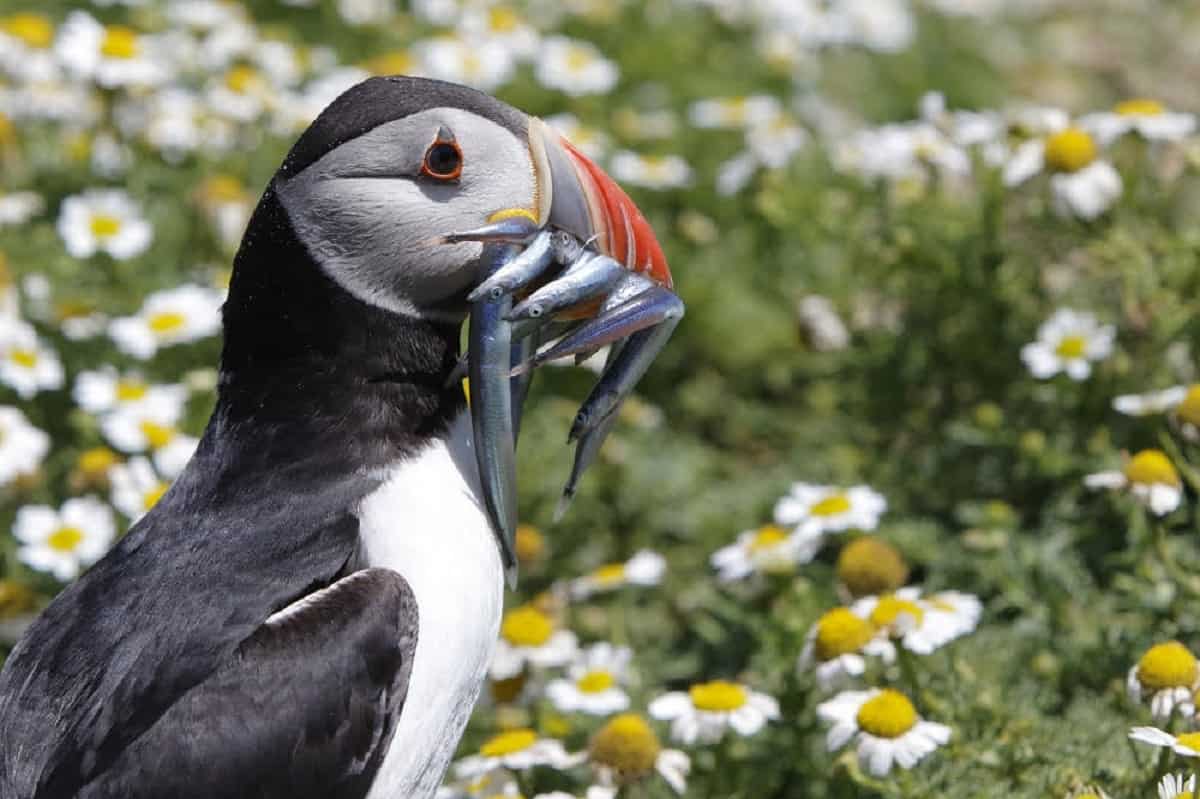
Atlantic Puffins (Fratercula arctica) are incredibly charismatic, with their lovely colour-blocked, black-and-white patterning and brightly coloured bill, making them a favorite bird to spot with wildlife watchers and photographers.
Fact – A puffins beak or bill changes to a dull grey in winter.
Puffins have been dubbed the clowns of the sea, possibly because of their ability to bring a smile to many a person’s face, or even the stunning way their feathers lay in a perfect diamond shape around their eyes.
While small in stature, Puffins have sweet personalities, ensuring their young puffling gets the nutritious food they require.
They’re easy to view for those interested in seeing sea birds at closer proximity, however, make sure to leave a clear path between them and their burrow.
Atlantic Puffins are most numerous in Iceland, where over 60% of the world’s population is found. They can also be found on grassy, steep slopes throughout much of the northern European and northeastern North American coasts.
One of the most accessible places to spot Atlantic Puffins and British birds is Skomer Island in Wales. Here visitors can walk a rugged pathway near the beautiful Pembrokeshire Coast directly to a Puffin colony, as well as many thousands of other sea birds.
Puffins are best seen from April to July, as they spend the rest of the year out to sea, floating on the waves and foraging on various small fish.
Christa of Expedition Wildlife
This book by award-winning wildlife photographer Drew Buckley includes beautiful birds pictures of the UK’s beloved Puffins.
This unique book captures the beauty of this spectacular nature reserve in Wales. With over 100 colorful birds images it would make an excellent gift for any wildlife enthusiast.

We’ve seen many beautiful birds around the world. From Scarlet Macaws in Central America to pink Flamingos in Africa, but it’s the laughing Kookaburra that we enjoy the most.
These beautiful Australian birds have a snow-white head and underside. And dark brown wing plumage with splashes of blue. But we most love the Kookaburra’s dark brown eye-stripe that makes it look like a masked bandit!
The Laughing Kookaburra is so well- loved by Australians; it even inspired a popular children’s song that pays homage to the iconic bird’s laughter-like call.
This raucous cackle is a territorial call to warn other birds to stay away. It lives in eucalypt forests, and its distinctive sounds can be heard in bushland throughout Eastern Australia.
Our favourite place to spot them is at the pristine Wilsons Promontory National Park in the state of Victoria. Kookaburras use a ‘wait and swoop’ technique to catch prey and can often be seen sitting in a tree overlooking grasslands or bushland.
Like most amazing birds in the world, the best time to see Kookaburras is at dawn and dusk. But unlike other birds, you’ll most likely hear it laughing at you long before you lay eyes on it!
Click here to see a Kookaburra enjoying a tasty snack.
Audrey Chalmers of Gumnuts Abroad
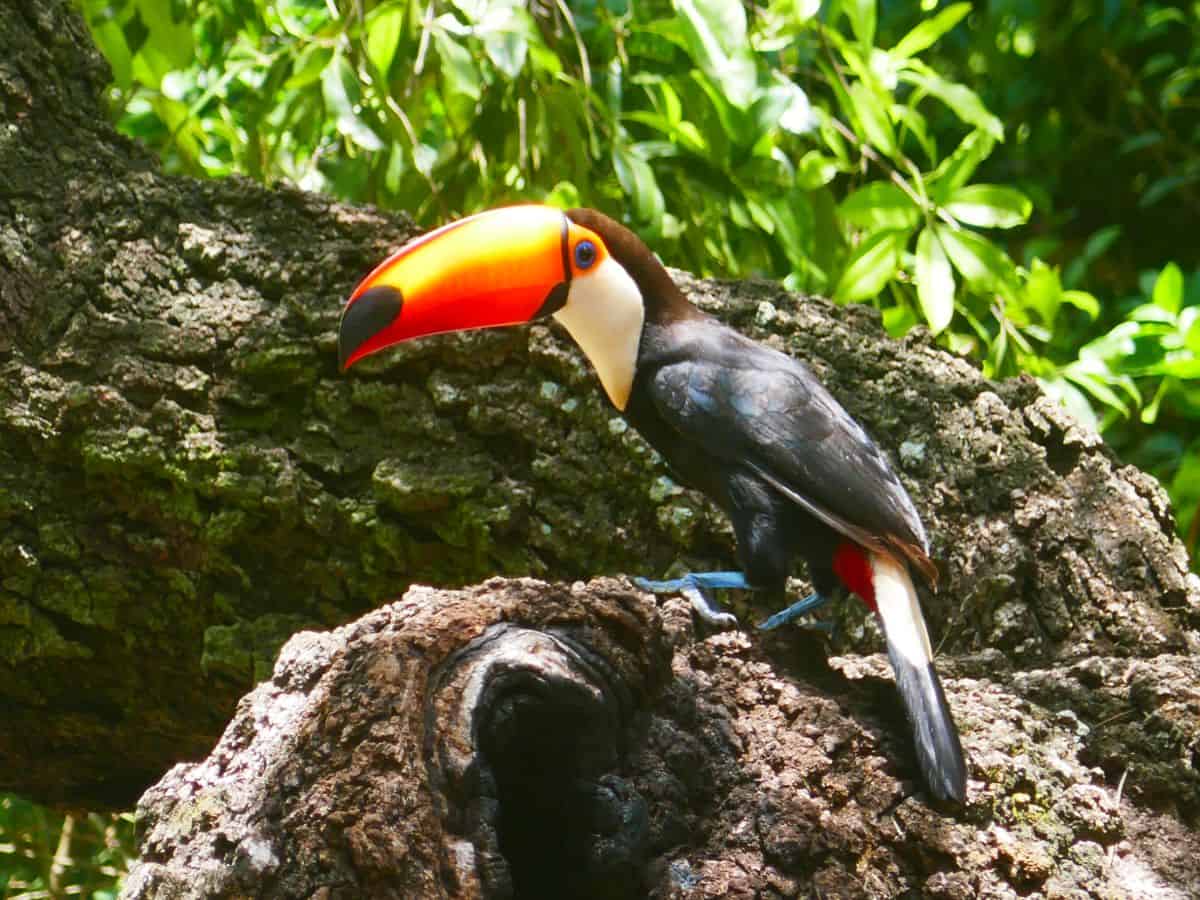
In the many months that I’ve spent traveling through Central and South America, I’ve had a few sightings of Toco Toucans, either flying through the air or fluttering high up in the branches of a tree.
I was always fascinated by the enormous beaks of these colorful birds, which were easily spotted even from a far distance. But when I had the chance to get up close and personal with one of these majestic, exotic birds, I came to appreciate their beauty even more.
It happened at the Santa Clara Pousada at a camping site in the Pantanal wetlands of Brazil. Our guide Pedro knew that a Toucan had made a nest inside a hole in a tree behind the Pousada.
He warned us to be quiet and to get our cameras ready as we tiptoed up to the tree. Suddenly, the Toucan popped out of his hole and stared inquisitively at us for a few seconds before flying up to the cover of the tree’s branches.
In awe, I tried to take in as many details of his features as I could. In previous Toucan sightings, all I’d been able to catch were glimpses of their prominent beaks.
But now, I could also see that his little blue feet matched the color of his eyes, and I could admire how his black feathers glistened in the sun. It’s a sight I’ll never forget.
Wendy of Nomadic Vegan
This is a helpful and easy to use quick reference guide if your heading to Brazil for some bird watching. It includes a map of the best viewing areas and features 140 species. It’s also lightweight, pock sized and laminated to protect it.
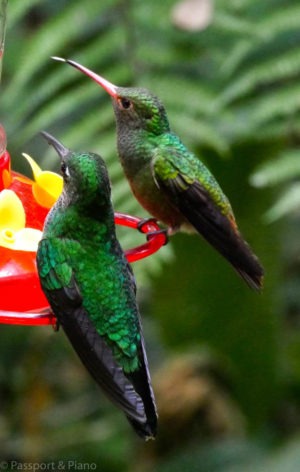
The Hummingbird or Colibri in Spanish is for me the most beautiful bird. The Colibri is native to the Americas and is known for its small size and speed. The smallest hummingbird species weighs just 2 grams and measures only 5 cm.
They’re known as Hummingbirds because of the sound that their wings make when they fly. Hummingbirds hover, mid-air, with their wings beating at rates of 12 beats per second to over 80 beats per second for the smallest varieties.
They have the highest metabolic rate of animals of their type because of this. These are fast as well as stunning birds, and hard to capture on film for the amateur photographer and traveller.
There are numerous varieties of hummingbirds, and their many different colours make them one of the worlds most beautiful birds. However, for me, it’s their delicacy and speed that appeals.
You mostly only catch a glimpse of them from the corner of your eye and it’s this elusiveness that makes them beautiful birds.
Fact – Hummingbirds can fly backwards.
Although we’ve seen them throughout Central and Southern America, it was near Salento that we spotted them, while hiking the Valle de Corcora.
The Acaime Hummingbird sanctuary is found on a diversion from the standard hiking route and is home to hundreds of Hummingbirds – a glorious retreat and such a stunning place to sit and have breakfast while birds flit past your head – positively one of the best things to do in Salento.
Sarah Carter of ASocialNomad
To see more beautiful South American birds and hummingbirds click here to read about bird watching in Mindo.
Any birder or natural history reader will love this delightful book. It would also make a great book for a coffee table with beautiful bird images and a wealth of information to enjoy.
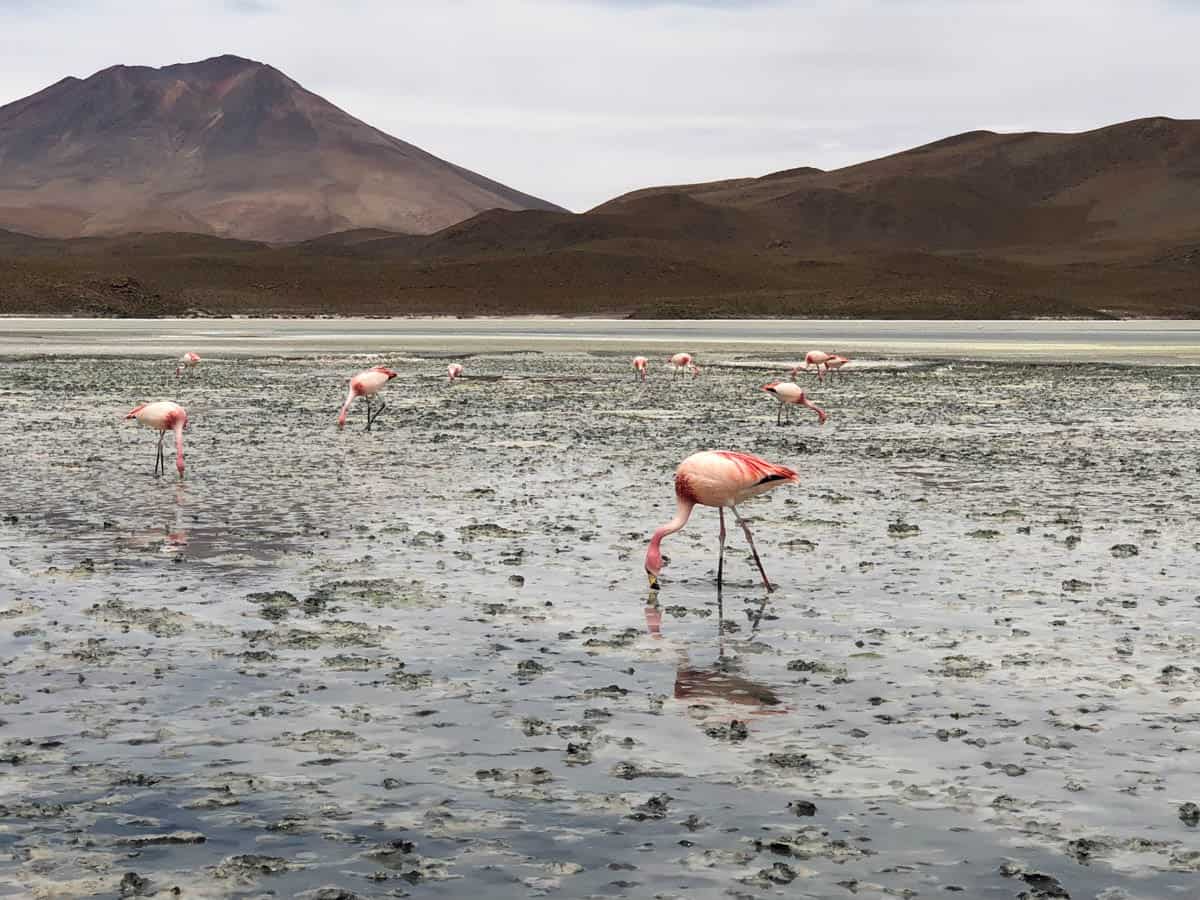
I believe the Uyuni Salt Flat in Bolivia is on everybody’s travel bucket list. On our pilgrimage to the salt flat from Atacama, Chile, we drove through the Eduardo Avaroa Andean Fauna National Reserve, where we observed three endemic species of flamingos in their natural habitat.
Embraced by volcanoes, geysers, hot springs, lagoons, fumaroles, and more, it’s a beautiful place to see these wild birds.
The National Reserve is located at an altitude between 4,200m and 5,400m – that’s why we finished our entire trip with our hearts pounding not only because of our reactions to the high altitude but also the distinct beauty of the landscape.
The remote area in Sur Lipez is home to more than 30,000 Flamingos and three out of the six Flamingo species in the world can be seen here: the Chilean, Andean, and James’s Flamingo.
There are plenty of lagoons in the highlands. They provide an abundant supply of plankton that draws these wonderful birds to the water; most of our sightings happened around the lagoons. If you are lucky, you may get to see all three species in a day.
The James Flamingo can only be found in such high Andean plateaus and are one of the worlds rare birds. They were thought to be extinct until they are spotted again in the 1950s.
Fact Flamingos are white. They look pink as the red algae in the water stains their feathers.
The best time to view the birds is between December to April, as the lagoons are full from the rain of the wet season.
The Andean flamingo is also diminishing in numbers, and although the IUCN does not list it yet as one of the worlds endangered birds, conservationists are concerned about its numbers.
Kenny of Knycx Journeying
The Nata Bird Sanctuary near the Makgadikgadi Pans in Botswana is another excellent place to see flamingoes in their thousands.
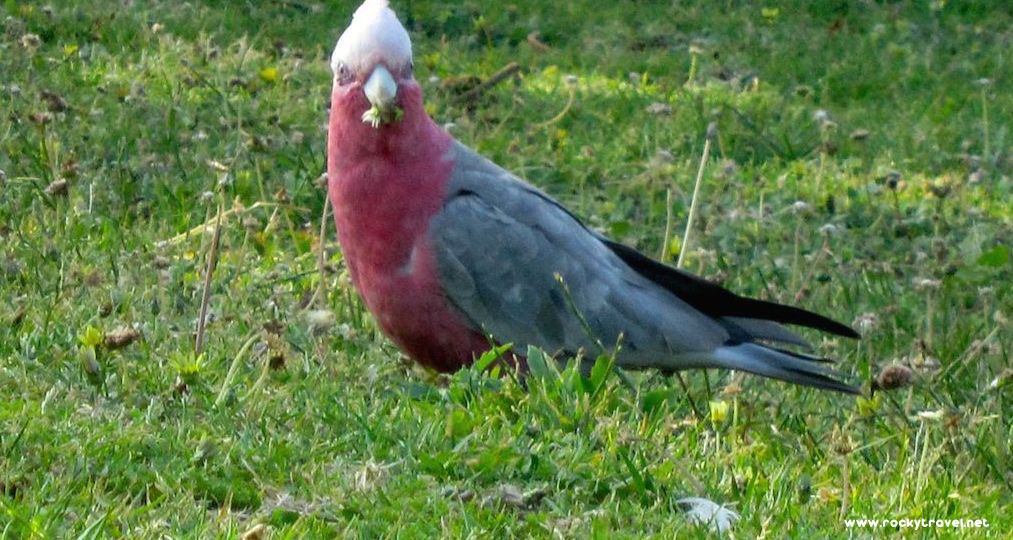
Australia has got over 800 species of native birds. With so many different birds, it’s challenging to choose one, but my favourite is the Pink Galah. It’s a beautiful pink, and grey cockatoo which is easy to spot.
They are found in many metropolitan areas like Melbourne, Perth and Adelaide.
Pink Galahs love to gather on green lawns and perch on trees, but they’re not as intrusive as the cheeky cockatoos, who try to steal your food.
I also saw storms of pink galah in the Australian Outback and loved taking pictures of them. It’s always a delight to come across them; they are not as big as common cockatoos.
If you’re planning a trip to Australia you may find this post on the best Australian landmarks helpful.
They are smaller, in shape, at only 35 cm (14 inches) long and weigh between 270-350 g (10-12 oz). This is why people love them. Their small size makes them more approachable, and less scary than the white and black cockatoos which are double if not three times the size.
This Australian native bird has a pale silverback, a pink face and chest and also a pink crest. The female and male are a bit different. The male Galah is more elegant than the female who has reddish eyes too.
I think Australia has got some of the most beautiful animals in the world, and colourful native birds like the Pink Galah are the ones you will remember from your travels.
Michela of Rocky Travel
Australia has some magnificent animals and if your visiting between July and November it’s worth going on a whale watching tour and spending some time at the Great Barrier Reef.
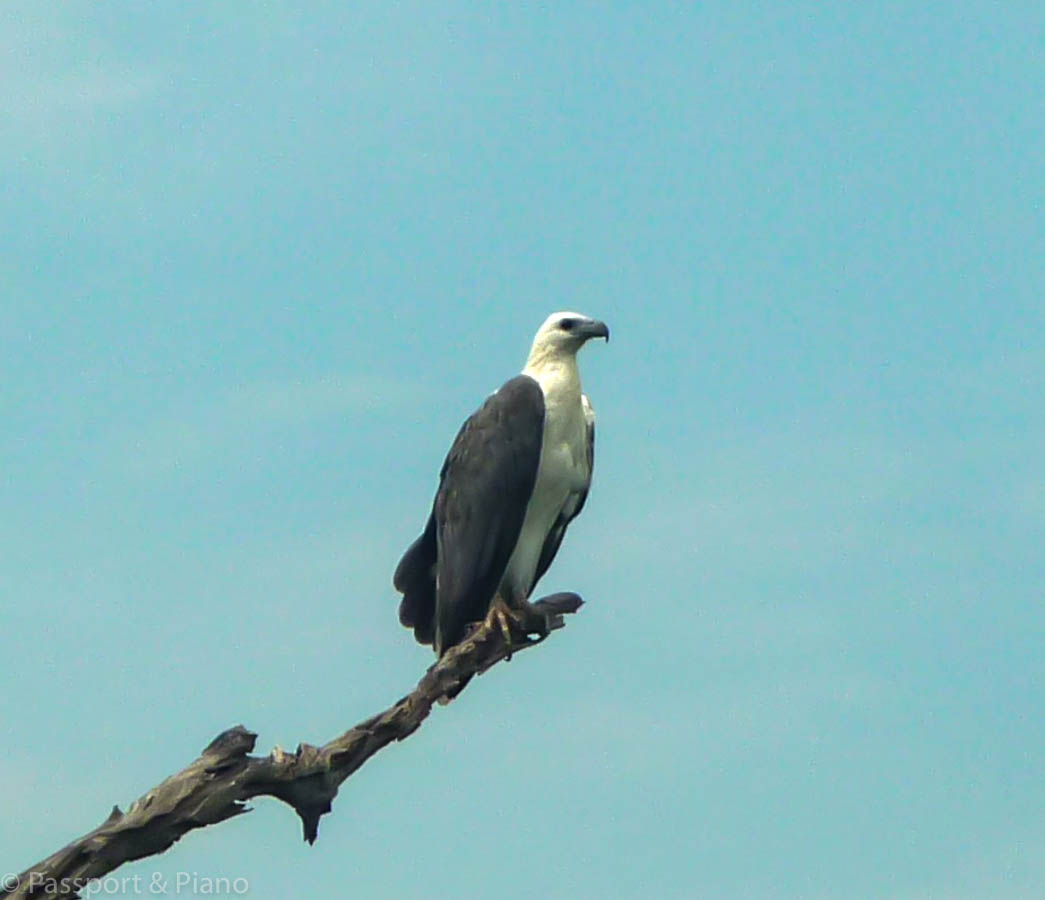
You’ll often find birds of prey when searching for the top 10 birds in the world. This white-bellied sea Eagle is one of the best bird images taken from my birdwatching trip in Darwin Australia. It’s one of the most beautiful birds of prey I’ve seen.
This big bird weighs anything between 2.5kg-3.7kg and has a wingspan of up to 2m. It’s white, and bluish grey feathers are far more attractive than the brown ones that many of its relatives have.
They can be seen soaring above the waterways or perched on a nearby tree along much of Australia’s coastline. However, you may also see them in New Guinea, Indonesia, China, South-East Asia or India.
I took the picture above on a cruise through the Mary River Wetlands. This is a great area for bird watching if you’re visiting the Northern Territory.
Fish form about 50 per cent of this birds diet along with other aquatic animals. It’s a skilled hunter and will attack anything up to the size of a swan. It’s also known to attack and steal food from other birds.
Fiona from Passport and Piano

The Peacocks spectacular tail feathers make this the prettiest bird in the world. I may be slightly biased as these images are of the one that lives in my garden at home. We didn’t buy him, he found us, and for the past eight years, he’s lived on our chimney.
While most people refer collectively to the male and female as Peacocks, it’s only the male that is a Peacock. Together they are called peafowl.
Males use their magnificent tail feathers to create a beautiful fan and of course, attract the Peahens. The females are believed to choose their mate based on the size and colour of these beautiful feathers.
Beautiful birds don’t get any more stunning than when the Peacock displays its tail.
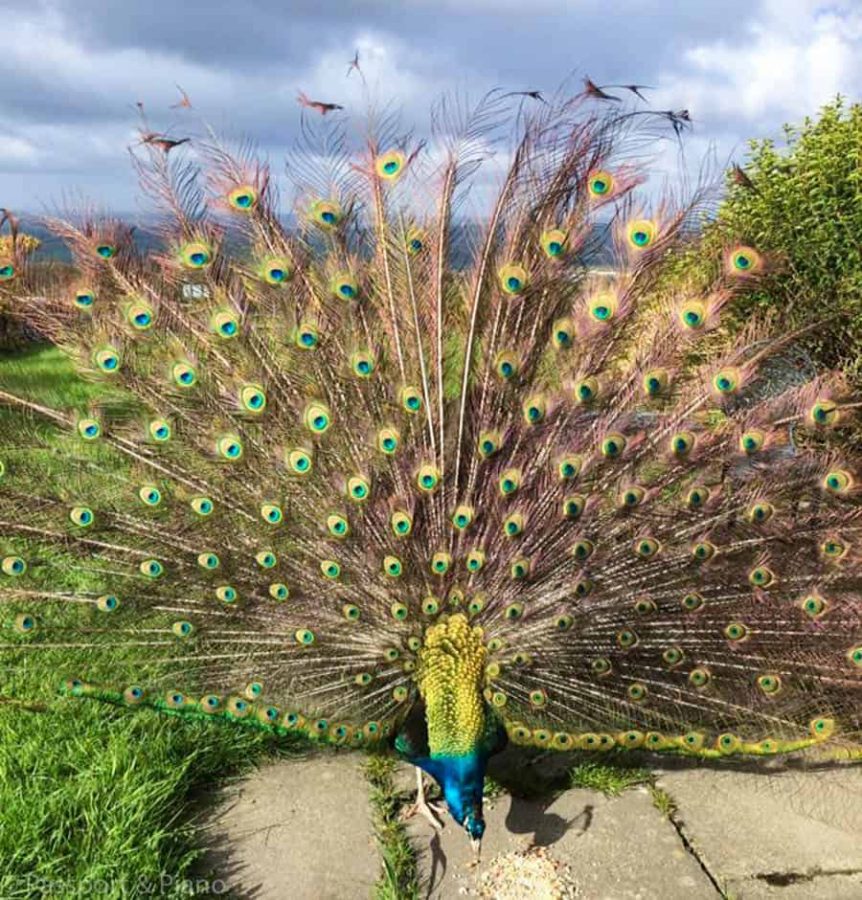
Peacocks are native to India, but they are a common sight around the stately homes in the UK. The Romans are thought to have introduced them, and the UK does not class them as a wild bird.
We live in rural Lancashire, and it’s likely that the Peacock that adopted us, once belonged to a local farm. We supplement his diet as he cannot survive by foraging for himself. He can be quite territorial with people he doesn’t know, but he’s also incredibly gentle and will fly down whenever you call him.
Peacocks are native to India, but they are a common sight around the stately homes in the UK. The Romans are thought to have introduced them, and the UK does not class them as a wild bird.
We live in rural Lancashire, and it’s likely that the Peacock that adopted us, once belonged to a local farm. We supplement his diet as he cannot survive by foraging for himself. He can be quite territorial with people he doesn’t know, but he’s also incredibly gentle and will fly down whenever you call him.
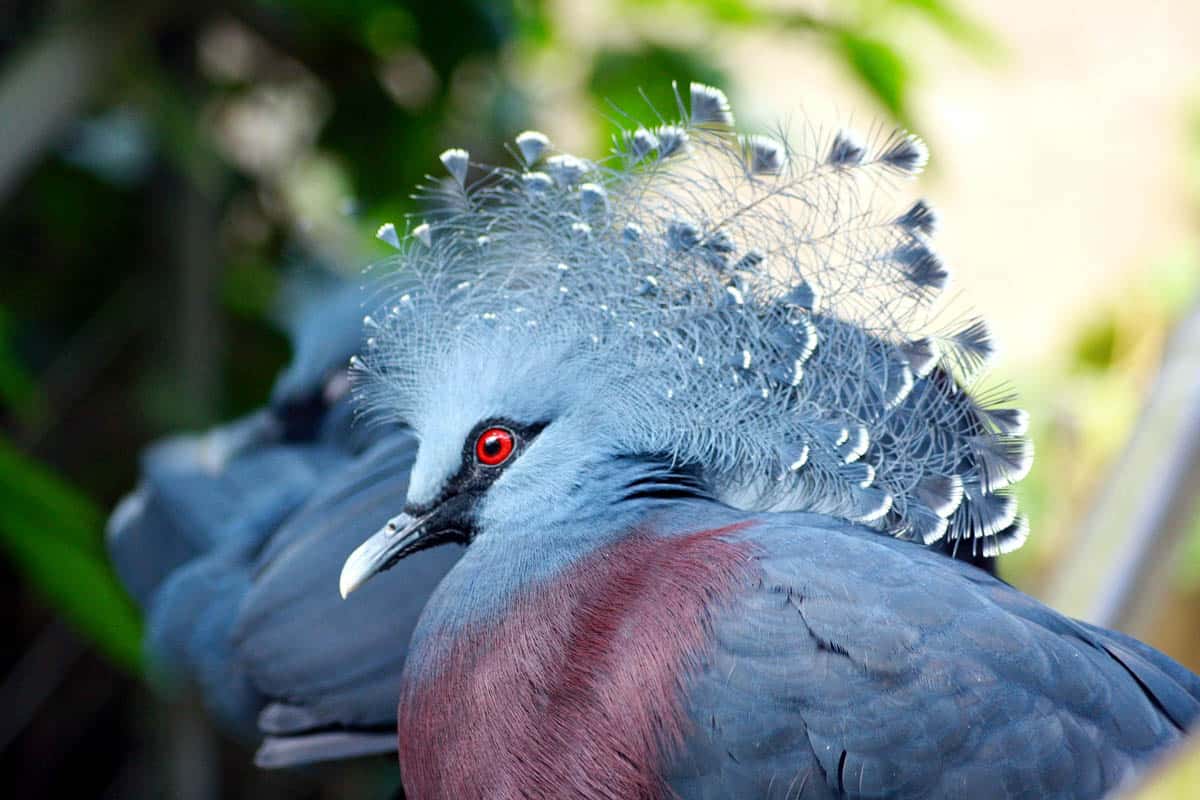
This is a bird that I’d love to see in the wild. Its native to the swamp forests of New Guinea and the birds pretty crown is stunningly beautiful. Although its quite common to see these birds in captivity there status in the wild is declining. This is mainly due to loss of habitat.
Sadly it is also hunted for its meat and feathers, but thankfully it is now illegal to trap it for sale into captivity. It’s on the IUCN red list and classed as threatened, and reproduction is slow as the female only lays one egg.
They can grow up to nearly the size of a turkey, but they weigh much less. Its blue, lilac and purple feathers are stunning but its the intricate lace crown feathers that make these birds pretty.
They spend much of their time foraging for food on the ground and can only fly short distances. They’re intelligent birds and easy to tame, hence why people keep them in captivity.
The Victoria Crowned pigeon is the largest in the species and the closest remaining ancestor to the extinct Dodo.
Fact- Eleven per cent of the world’s bird species are endangered
Interested in some-more rare birds? Check out this post on Things to in Mauritius and learn more about the Pink Pigeon.
That brings us to the end of our list of the 20 most beautiful birds in the world. If your looking for even more inspiration check out these books that come highly recommended.
This is a beautiful book that has a poem to compliment each of the birds. It would make a wonderful gift or coffee table book.
This is a fantastic book that showcases all 39 Birds of Paradise native only to specific regions of New Guinea. The photographs are exquisite, and the text describes the unique behaviour of these beautiful birds.
Passport and Piano is a participant in the Amazon Services LLC Associates Program, an affiliate advertising program designed to provide a means for sites to earn advertising fees by advertising and linking to amazon.com, amazon.co.uk, amazon.ca. Amazon and the Amazon logo are trademarks of Amazon.com, Inc. or its affiliates.












